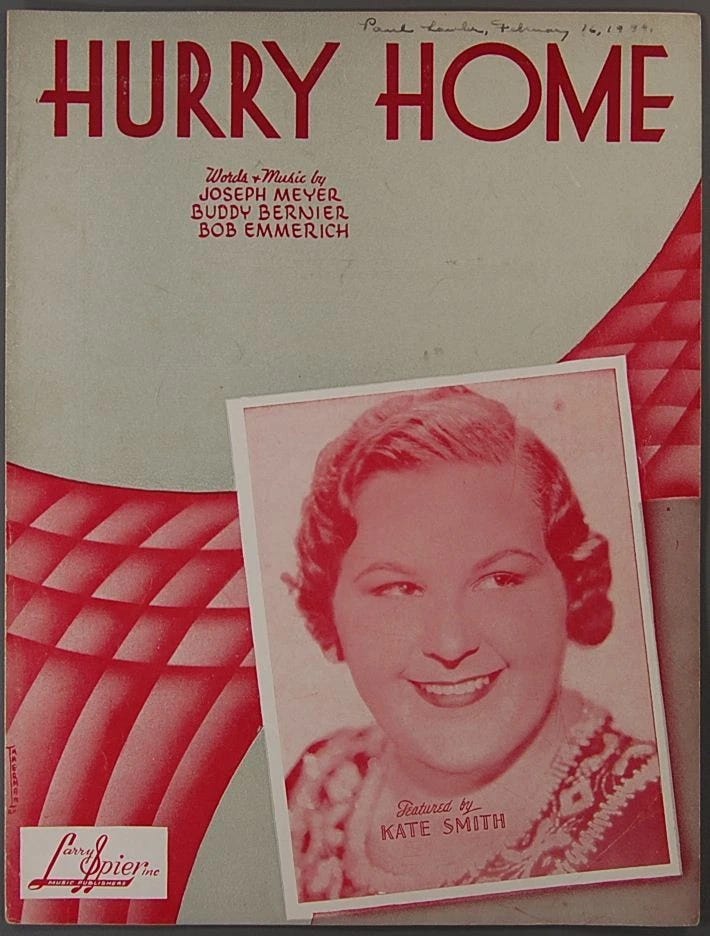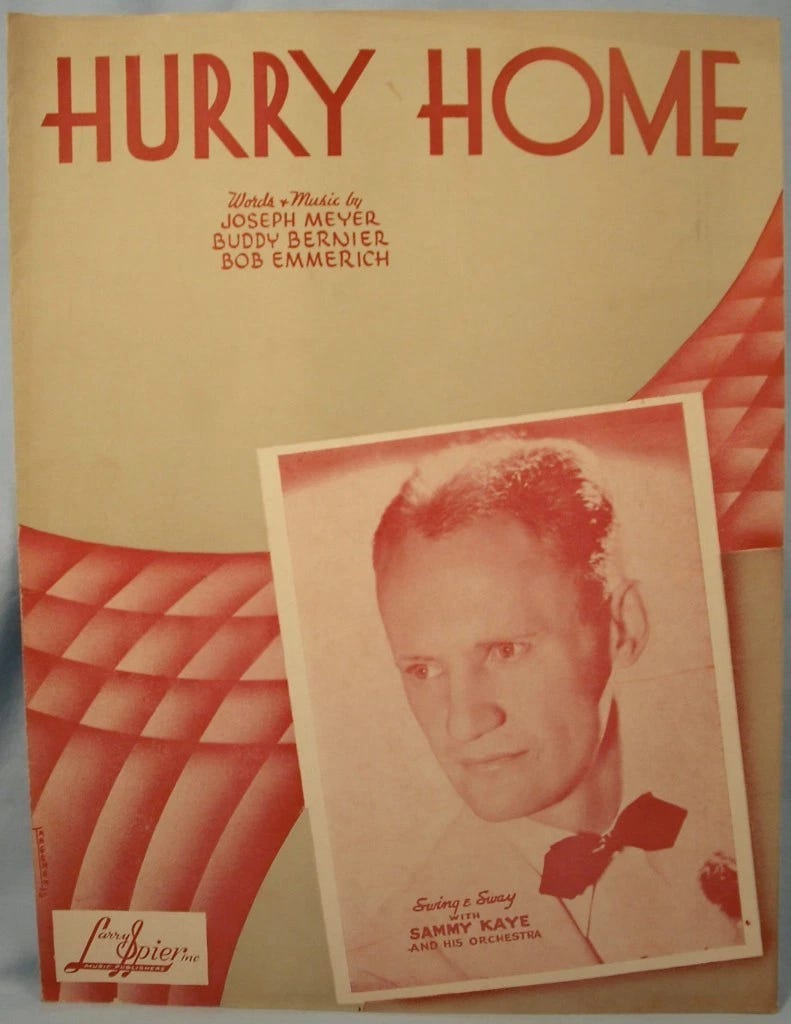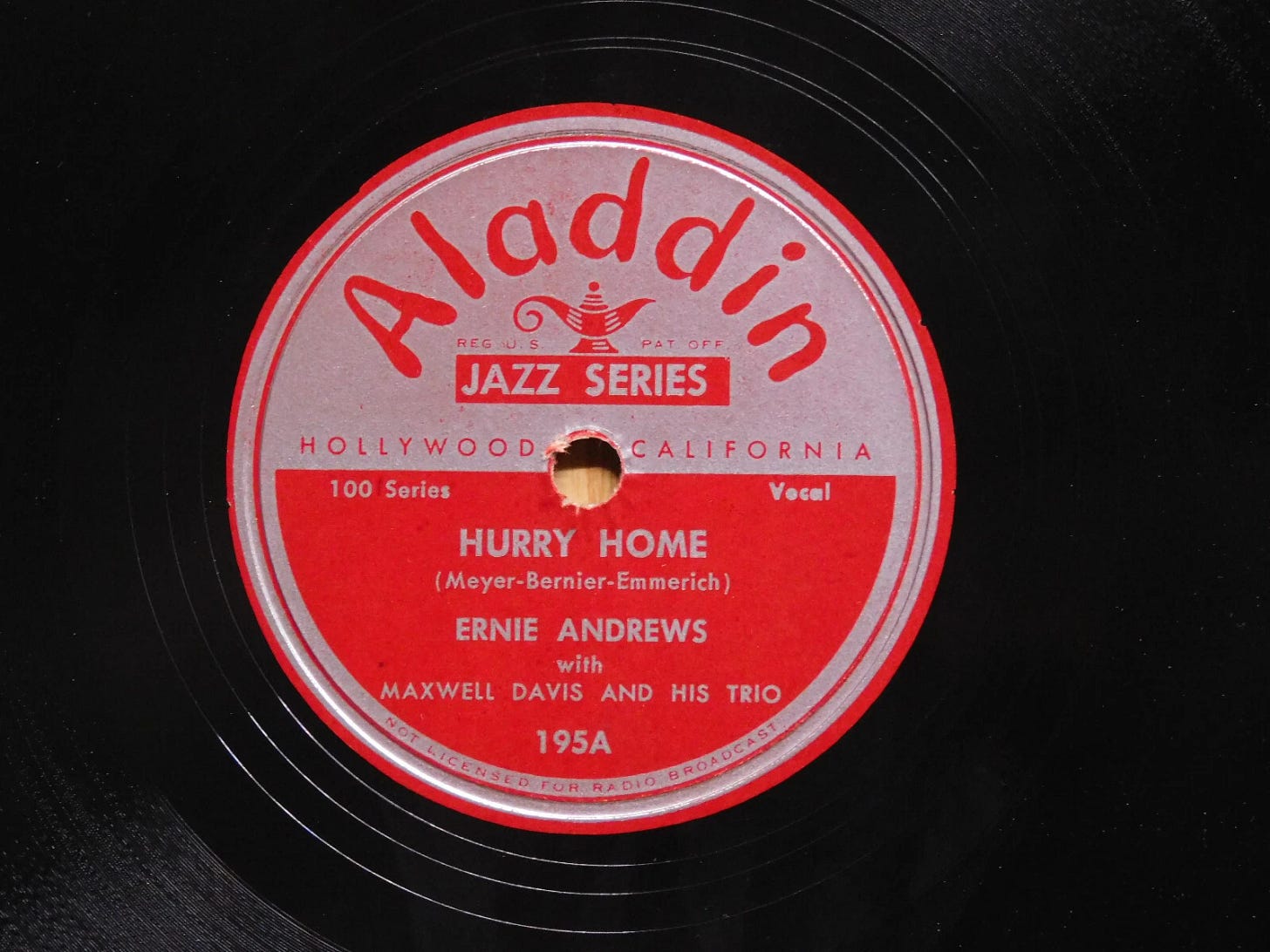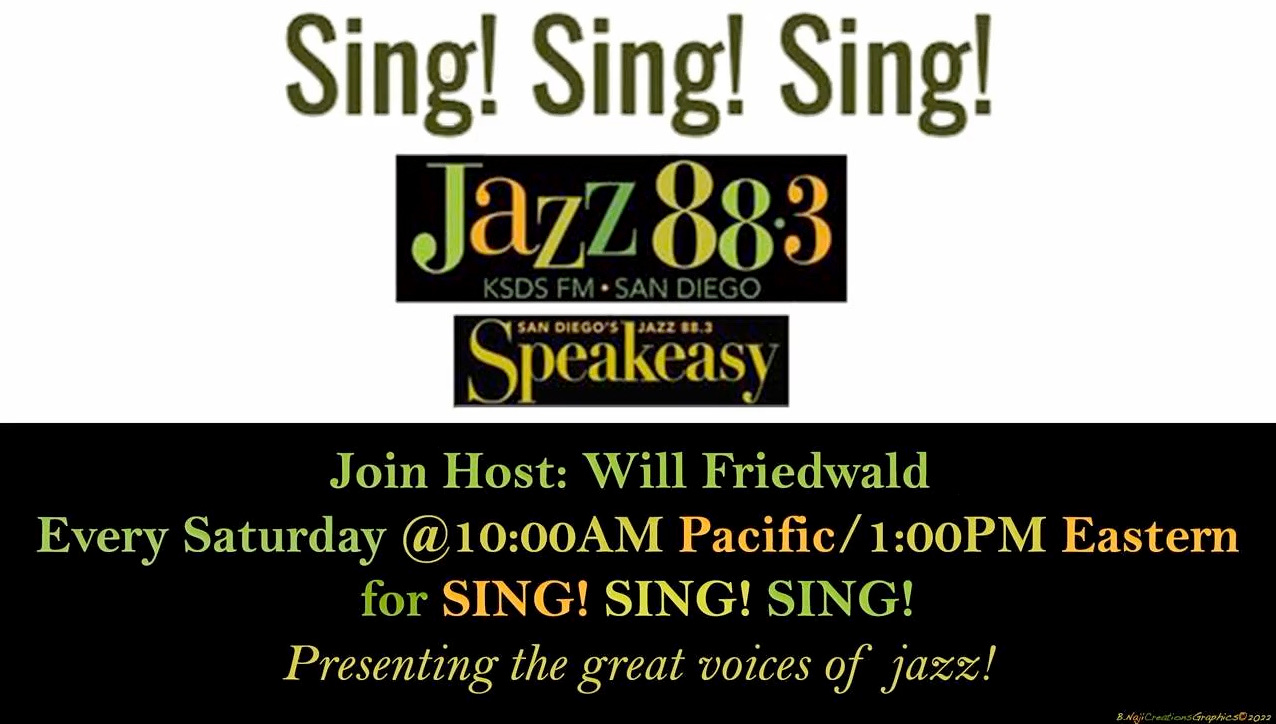Seth MacFarlane ("Lost Sinatra Arrangements") Part 2: "Hurry Home"
from the brand new "Lush Life: The Lost Sinatra Arrangements"
First an announcement: Seth MacFarlane is going to be my special guest on next week’s episode of Sing! Sing! Sing! Heard on Saturdays on KSDS Jazz 88.3 San Diego (more details below as to how to listen online). That will be on Saturday June 28, 10:00AM Pacific or 1:00PM Eastern, but anytime over the Podbean app. (again Details below.) My previous writings about this amazing new album may be found below:
The Wall Street Journal (June 14, 2025)
Substack (this very Substack)
“Hurry Home”
Words & Music by Buddy Bernier, Bob Emmerich, & Joseph Meyer
Published by Larry Spier Inc., 1938 (1619 Broadway - The Brill Building)
This has always been a personal favorite of mine. But much more importantly, it’s very notably a song by a trio of white songwriters - significantly lesser-known ones - that has always found favor with Black singers and bands. If there ever was such a thing as a “Soul Songbook,” this song - along with “Trust in Me” (Jean Schwartz & Milton Ager, although I love the Jungle Book song as well), “Dedicated to You,” “Candy,” and “Unchained Melody” among others - would be in it; all are songs by white writers that have been copiously sung and recorded by Black artists.
In fact, it warms the cockles of my heart that Sinatra liked the song well enough that he commissioned a chart from the great Nelson Riddle. It’s true enough that Ella Fitzgerald recorded her very lovely reading shortly before Sinatra and Nelson went to work on their own version. However, the song was well-known enough way before Ella’s Like Someone In Love album - in fact, her track was so awesome that I suspect it had the opposite effect on Sinatra. It convinced him not to go ahead and record the song.
“Hurry Home” is firmly associated with the R&B era and the Central Avenue scene, but it was first recorded by one of the least jazzy and un-bluesiest dance bands of all time, the very Mickey Mouse unit helmed by Sammy Kaye - which was billed not as “Sammy Kaye and his Orchestra,” as you might expect, but as “Swing and Sway with Sammy Kaye.”
The song was written by Buddy Bernier and Bob Emmerich, who would have a few notable songs in their future careers, most prominently “The Night Has a Thousand Eyes,” which also occupies a prominent place in the Soul Songbook. We’ve already talked about the third partner, Joseph Meyer, who wrote several minor songs with Johnny Mercer but also the 1920s jazz standard “Blue River.” as I wrote here a few months ago, it’s because of Meyer’s song “Blue River” that many years later, Mercer and Hank Mancini titled their song “Moon River” rather than “Blue River.” (And here’s that substack story on “Blue River.”)
verse:
Gee what a wonderful day to be glad, but I’m sad.
The fact that you’re so far away
Makes me wish you were here,
Beside me, my dear.
First chorus:
I had to call you on the 'phone
Because I feel so all alone
Don’t like this being on my own
Can't you won't you (“can’t-cha, won’t-cha”) hurry home
I’ll leave the door unlocked in case
Like me, you find you're out of place
I'd give the world to see your face
Can't you, won't you hurry home
I've learned a lot that I didn't know
I was a fool when I let you go
Since you've been gone it’s all very clear
Life is just an empty thing without you, dear
I made an awfully big mistake
Oh, what a difference love can make
Please give my heart another break
Can’t you, won't you hurry home
Second Chorus:
The dishes pile up everywhere,
There’s nothing in the Frigidaire,
Can’t find a comb to comb my hair.
Can't you won't you (“can’t-cha, won’t-cha”) hurry home
I set the clock to ring at eight
It didn’t work - so I was late
I'm worried 'cause I'm losing weight
Can’t you, won't you hurry home
Our pet canary simply won't sing
There's something wrong, the doorbell won't ring
When you're away it's all very clear
Life is just a bowl of sour milk, my dear
I'm tired of eating food that's canned *
And nothing's turned out like I planned
I know that you will understand
Can't you, won't you hurry home.
(Seth changes this line to “my tears are always close at hand.”)
Even though it’s a lyrical simple song - despite the triple rhyme scheme - it’s direct and straightforward. Perhaps the best word is “sincere.” The combination of the straightforward lyric and the harmonically progressive music made the song very appealing for at least a generation or so after the song was first heard, into the 1940s and ‘50s.
As Daniel Weinstein observes: This song has some subtle harmonic shifts that move it above the ordinary, and explain why Dizzy, Bird, Ella and others would have continued to revive it through the years. The main interesting chord movement is in the second half (beats 3 and 4) of the third measure of the A section, where the tonal center moves up a minor third, before moving back down to the "2" chord. This alone would have made it attractive to the young Turks of the blossoming modern jazz movement, but also, the bridge shifts tonalities to a major 3rd above the initial key of the song for 4 bars, another nice and somewhat unexpected move. It then moves to the "5" of the starting key, bringing the last 8 home in the usual fashion. (The change in tonalities at the bridge is the same one that was also used in "The You and Me That Used to Be" by Walter Bullock and Allie Wrubel, from 1937.)
Swing and Sway with Sammy Kaye, vocal by Charles Wilson
This is what is believed to be the first recording (September 26, 1938), which is light years away from jazz, blues, Ella, or Sinatra. Be warned: this is an extreme sweet band - Mickey Mouse up the wazoo - it makes Guy Lombardo sound like Stan Kenton by comparison. The whole melody is couched in rickety-tickety phrases, set in a strict 2/4 businessman’s bounce, with a brass section that isn’t so much moaning as snoring. Note the use of such gimmicks such as a “singing song title” at the start and a radio style intro by the leader of boy singer Charlie Wilson, who at least sings in tune and enunciates the lyrics clearly. (Nearly all of these year one 1938 recordings only use the first chorus of lyrics.)
Al Donahue and his Orchestra, vocal by Paula Kelly (1938)
Al Donahue’s band wasn’t particularly distinguished, but at least he plays the song in a danceable 4/4 - hey, this is the swing era after all - and Donahue has a better-than-average singer in Paula Kelly, who would go on to work with Glenn Miller and the Modernaires. The band plays with spirit, particularly after the vocal, and there’s a brief clarinet solo on the bridge, clearly in a Benny-Artie vein.
Bob Crosby and his Orchestra, vocal by Bob Crosby (1938)
This is the best of the early versions; if I could only pick one, this would be it. Eddie Miller’s tenor sets the tone perfectly in the first chorus. Baritone Bob Crosby was too often regarded as second best - he was never going to be the best singer in the world when he wasn’t even the best singer in his own family. Still, he’s a more than competent band crooner who puts the lyrics over well. (Yes, he did learn a thing or two from his big brother.) Here’s hoping this makes the cut on Mosaic Records’ forthcoming Bob Crosby boxed set - fingers crossed.
Teddy Stauffer Mit Seinen Original Teddies (March 1939)
No one wants to think about what was going on in Berlin in March 1939 when this was recorded by Nazi Germany’s #1 swing-style dance band, but it’s a slick and serviceable performance with more clarinet. Clearly those “degenerate” Jewish bandleaders, Benny and Artie, were an important inspiration, in spite of the Third Reich dictates. A muted trumpet takes part of the melody on the opening chorus, while the central chorus - the one that would be the vocal - is divided between clarinet and tenor (on the bridge). The beat is a little rigid - you can really hear the guitarist chunking away, but it’s a good indicator of how the song’s popularity spread beyond America - and even beyond America’s allies.
Thelma Carpenter assisted by The Deep River Boys and accompanied by Bud Freeman and his Orchestra (October 1945)
Thelma Carpenter was a wonderful singer who dwelt in the space between big bands, R&B, and Great American Songbook-style pop singing, and whose career ranged from Count Basie’s Orchestra to Eddie Cantor’s radio show to The Wiz. (The pop music scholar Alan Eichler has compiled several essential collections of Carpenter’s singing, most recently an excellent set of her vocals from the Cantor program on the British Jasmine label - info here)
This early postwar track was likely produced by John Hammond, and is a true model of racial integration: an African American singer with a Black vocal group (The Deep River Boys, another group like the Delta Rhythm Boys, who split the difference between gospel music and mainstream pop), a star white instrumentalist serving as both bandleader and key soloist. Bud Freeman sounds like he’s been listening to Eddie Miller on the 1938 Bob Crosby recording, although we know Miller was actually one of Bud’s devotees. After the tenor solo, Carpenter returns with a final eight bars, although she repeats the lyrics of the end of the first chorus rather than moving on to the second.
Ernie Andrews with Maxwell Davis and his Trio (1947)
Ernie Anderson, one of the great transitional crooners - equally versed in R&B, pop, and jazz - recorded this for Aladdin Records in 1947. Alas, this is one of the rarer tracks; the two collectors I would have thought were most likely to have it, Kenny “The Jazz Maniac” Washington, and Billy "At This Moment" Vera, both came up empty! If anyone has it, let me know.
Buddy Stewart with The Charlie Parker Quartet, Live at the Royal Roost, March 5, 1949
Not that it’s a significant point, but this might be the first version of the song I heard - which is one reason why I was surprised to learn that the song itself went back as far as 1938. Buddy Stewart is a highly modern, bop-inflected crooner - I wrote a lot about him in one of my early books, Jazz Singing - an even more modernistic counterpart to Mel Tormé and a contemporary of both Jackie Paris and Mark Murphy. His note choices and tone make him a perfect collaborator for none other than Charlie Parker himself, and he also adroitly combines the lyrics from both choruses, the first 16 bars of the first with the second 16 bars of the second. (Charlie Parker, alto saxophone; Al Haig. piano; Tommy Potter, bass; Max Roach, drums.)
Dizzy Gillespie Quintet (Paris, March 27, 1952)
John Birks Gillespie was an under-appreciated balladeer, and here he proves that he’s as great a singer of love songs as Billy Eckstine, Austin Cromer, Joe Carroll, Johnny Hartman, or any of the other top-drawer crooners he worked with. This a lovely, short, and to-the-point rendition of the melody, with minimal embellishments, and very heartfelt. Dizzy cut two distinct takes of this in Paris in 1952 with a group including the great expatriate tenor master Don Byas, heard only in the background, and a rhythm section of pianist Arnold Ross, bassist Joe Benjamin, and drummer Bill Clark. (Gillespie re-recorded the song, playing mostly muted, in 1974, in a quartet setting - which the 1952 version essentially is - on the Pablo album Dizzy Gillespie’s Big 4, with Joe Pass, Ray Brown, and Mickey Roker.)
Louis Jordan and his Tympany Five (April 1954)
There’s no doubt that Sinatra would have heard Ella Fitzgerald’s version of the song, but I would also bet that he followed the wider world of pop music and jazz closely enough to be familiar with Louis Jordan’s 1954 single. It’s from one of Jordan’s first sessions after leaving Decca Records in early 1954, when his first stop was Aladdin Records - thankfully his terrific version is a lot easier to find than Ernie Anderson’s reading for the same label in 1947. (The arrangement was recreated in Five Guys Named Moe, the Louis Jordan tribute revue that played the West End in 1990 and Broadway in 1992, in which it was combined with “I Know What I've Got (Don't Know What I'm Getting)” a 1949 Louis Jordan ballad.) Like Gillespie, Jordan was a fine balladeer as well as a supreme comic.
Ella Fitzgerald Accompanied by Frank De Vol's Orchestra, featuring Stan Getz, from the album Like Someone in Love (Los Angeles, October 28, 1957)
This is one of Ella Fitzgerald’s minor miracles. The First Lady of Song recorded roughly seven excellent albums with arranger - conductor (and later producer and TV star) Frank De Vol. And while these aren’t generally listed as being among the highlights of her career, they certainly were the best work of De Vol’s; by comparison, his albums with Tony Bennett aren’t nearly as memorable. Fitzgerald and De Vol seem to be going for a definitive reading of “Hurry Home”; the performance is slow and deliberate, and she sings nearly all of both choruses - although at the start of the second chorus, she repeats part of the first, which seems like it might have been a mistake on the part of someone other than Ella. The tenor saxophone colossus appeared as a special guest on this album, Like Someone In Love (1957), but he doesn’t seem to be audible on this track.
One reason I prize Fitzgerald’s live concerts so highly is that she tended to do ballads more emotionally when there was a live audience present, but this is one of the most moving tracks she ever sang in the studio. There’s rarely such a thing as a definitive version of any Great American Songbook standard, but this one is so terrific you can see why Sinatra wouldn’t have wanted to mess with it.
(for “the record,” the Ella-De Vol albums are as follows…)
Like Someone In Love (1957)
Ella Sings Sweet Songs For Swingers (1958)
Get Happy (partially De Vol, 1958)
Hello Love (1959)
Ella Wishes You A Swinging Christmas (1960)
Ella Sings Broadway (1962)
Hello, Dolly (1964)
Seth MacFarlane: From the new Lush Life: The Lost Sinatra Arrangements (2025)
The Frank Sinatra Enterprises archivist, Charles Pignone, identifies this as a potential single that Nelson Riddle worked on in 1958, roughly around the same time as the epic Only the Lonely. No one, however, feels this was a candidate for Only the Lonely; the overall tone is much more similar to In The Wee Small Hours, from three years earlier. Wee Small Hours would have been a better spot for a tune with more of a jazz tradition, obviously, although there are certainly some blues and jazz oriented pieces on Only the Lonely, not to mention “Baby, Won’t You Please Come Home” on Where Are You? It’s a stunning chart, and Seth sings it extremely well, and also represents a case where he deliberately changed one of the key lines, “I'm tired of eating food that's canned” is replaced by “my tears are always close at hand.”
There are many other recordings of the song, including Mavis Rivers, a Sinatra favorite, and Dakota Staton, as well as Dizzy Gillespie’s 1974 version. Here’s hoping that Seth MacFarlane’s impressive performance inspires other contemporary performers to take up the song. And maybe, just maybe, someday somebody will even sing the verse.
(Very special thanks to Elizabeth Zimmer & Dan Fortune for their expert proofing, hey!)
Coming on Wednesday June 25 @ 7:00PM, THE NEW YORK ADVENTURE CLUB presents 'SHOW BOAT: EXAMINING THE BROADWAY MUSICAL THAT CHANGED EVERYTHING' webinar (All presentations are available for replay viewing for one week after the live event. For more information & reservations, please click here.)
Sing! Sing! Sing! : My tagline is, “Celebrating the great jazz - and jazz-adjacent - singers, as well as the composers, lyricists, arrangers, soloists, and sidemen, who help to make them great.”
A production of KSDS heard Saturdays at 10:00 AM Pacific; 1:00 PM Eastern.
To listen to KSDS via the internet (current and recent shows are available for streaming) click here.
The whole series is also listenable on Podbean.com; click here.
SING! SING! SING!
LOUIS ARMSTRONG: International Satch (“A Wonderful World”)
(SSS #153 2025-06-21 - 2025 LOUIS ARMSTRONG BIRTHDAY SPECIAL)
download: <OR> play online:
INSIDE ART Dave Drexler interviews Will Friedwald re NIGHTS AT THE RED STEINWAY (2025-06-22)
download: <or> play online:
Father's Day (“My Old Man”)
(SSS #152 2025-06-14)
download: <or> play online:
Nelson Riddle
(SSS #29 2023-01-14)
download: <or> play online:
Let's Spring One! (Sing Sing Sing goes Spring Spring Spring!)
(SSS #149 2025-05-24 - Spring 2025, Part 2)
download: <or> play online:
The Charles Strouse Jazz & Pop Mixtape (RIP 1928-2025)
(SSS #062 2023-09-02)
download: <or> play online:
SLOUCHING TOWARDS BIRDLAND is a Substack newsletter by Will Friedwald. The best way to support my work is with a paid subscription, for which I am asking either $5 a month or $50 per year. Thank you for considering. (Thanks as always to Arlen Schumer for special graphics.) Word up, peace out, go forth and sin no more! (And always remember: “A man is born, but he’s no good no how, without a song.”)
Note to friends: a lot of you respond to my Substack posts here directly to me via eMail. It’s actually a lot more beneficial to me if you go to the Substack web page and put your responses down as a “comment.” This helps me “drive traffic” and all that other social media stuff. If you look a tiny bit down from this text, you will see three buttons, one of which is “comment.” Just hit that one, hey. Thanks!j
Slouching Towards Birdland (Will Friedwald's Substack) is a reader-supported publication. To receive new posts and support my work, consider becoming a free or paid subscriber.









Listening to “Some Enchanted Evening” from the recent radio program, it wasn’t a Billy Strange arrangement but H.B. Barnum. And of course, we remember the Maurice Jarre song from Dr. Zhivago recoded (Somewhere My Love) for That’s Life album. Kaplan muses on the Rodgers song “some say Frank’s pique at Richard Rodgers for a scolding reminder to sing his songs “as written” - hence the Barnum arrangement.
I only knew the song from Ella Fitzgerald’s version, played very very often, so a welcome revelation. The line about being tired of eating food that’s canned is such a familiar 20th-century image of bachelor domestic incompetence that I thought it was conceived for a male voice, or even possibly a male character in a musical.
The Teddy Stauffer video ends like the opening of Leni Reifenstahl’s “Olympia.” It’s wholly a filmization of hurrying home. Though only instrumental here, I infer that the song, and the meaning of its title, must already have been somewhat familiar to German audiences.